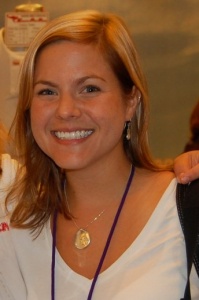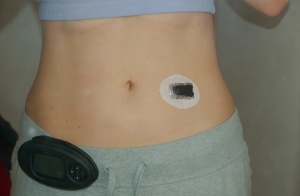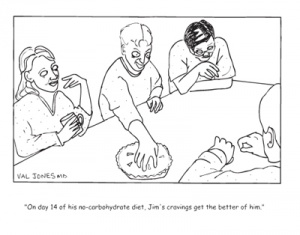November 15th, 2008 by Dr. Val Jones in Humor
No Comments »
My husband doesn’t like it when I go shopping with his credit card. But I tried to cheer him up about it. I said, “Honey, every purchase is a vote of confidence in your earning power.”
– Joan Horbiak, MPH, RD, at the Dairy Science Forum, November 13, 2008
November 15th, 2008 by Dr. Val Jones in Expert Interviews
1 Comment »
 It is estimated that 75% of our healthcare dollars are spent on chronic disease management, and that 80% of chronic diseases could be avoided with diet and lifestyle interventions. This means that the best way to decrease the size of our healthcare budget is to decrease the size of our collective waistlines. And that’s no small task.
It is estimated that 75% of our healthcare dollars are spent on chronic disease management, and that 80% of chronic diseases could be avoided with diet and lifestyle interventions. This means that the best way to decrease the size of our healthcare budget is to decrease the size of our collective waistlines. And that’s no small task.
Going back to basics – healthy eating and regular exercise – is such a simple message. But what is healthy eating exactly? Consumers are fairly exhausted by the complex messages they’ve heard about food and nutrition over the past couple of decades. One minute anti-oxidant foods are a miracle cure for everything from cancer to facial wrinkles, the next, it seems that they actually increase the risk of death. Diet advice ranging from low fat, low carb, to low sugar have all been promoted as the healthiest way to lose weight. But what does the evidence actually show? I decided to interview a series of experts to try to glean what I could about the state of nutrition knowledge. Today’s post is about protein – and I interviewed Nancy Rodriguez, PhD, a “protein scientist” to weigh in on this nutrient.
Dr. Val: We don’t talk about dietary protein needs that much, Nancy. Why is that?
Dr. Rodriguez: In the United States most people do get at least the minimum required amount of protein/day. The RDA (recommended daily allowance) of 0.8g/Kg of body weight is the amount you need to consume to avoid an outright protein deficiency. That’s about 3 ounces of chicken, fish, or meat/day – the size of a deck of cards. But the real benefits of protein include appetite suppression, and thermogenesis. Studies show that if people eat a little bit of protein with each meal, they’re less likely to become hungry between meals or consume as many calories overall. You also end up burning a few calories in the process of digesting protein.
Dr. Val: So what is the appropriate amount of protein intake?
Dr. Rodriguez: I have found that 1.2-1.5g/Kg may be optimal for hunger management. That means we should try to get a little bit of protein with each meal. Weight maintenance and loss is much easier to achieve if you don’t feel hungry all the time. Protein can really help with that.
Dr. Val: Is it possible to eat too much protein? Can it damage the kidneys in excess?
Dr. Rodriguez: I’ve conducted a few studies with participants eating 3g/kg of protein. That’s really hard to do. For example, you have to eat eggs and bacon for breakfast, 2 chicken breasts and veggies for lunch, and a 10oz steak for dinner. This is clearly in excess of what we need, though it’s hard to say if that level of protein is harmful. If someone has kidney disease, then obviously it would be a really bad idea to tax the kidneys with removing so many protein break down products. But people with normal kidney function didn’t seem to have a problem clearing the protein. Protein isn’t stored. When you consume more of it than your body needs, it is simply broken down and removed via the urine.
I personally don’t believe that excess protein causes kidney disease, but it can be a problem for those who have kidney disease. We would have to do some very long term studies of people eating very high protein diets for decades to find out if they end up with a higher risk of kidney disease. We just don’t know yet. But our kidneys have a tremendous reserve capacity to filter the blood. We can easily live with just one kidney – so it’s possible that healthy kidneys can handle high protein diets without injury. One thing that I certainly recommend – if you eat a lot of protein, you should drink a lot of water to help to flush out the break down products.
Dr. Val: Is it true that whey protein may help to reduce high blood pressure?
Dr. Rodriguez: Milk proteins are very interesting in that they contain a broad array of bioactive substances. There is increasing evidence that lactokinins can reduce blood pressure, but we just don’t understand the exact mechanism yet. We do know that people who eat more dairy products (included in the DASH diet plan) can lower their systolic blood pressure by an average of 10 mmHg.
Whey protein is also a natural appetite suppressant, so it can be helpful part of a weight loss strategy. Dairy sources of protein are an important part of a healthy diet.
***
I caught up with Nancy at the Dairy Science Forum on November 13th, 2008 in Washington, DC.
 |
|
Nancy Rodriguez
|
Nancy Rodriguez, PhD, RD, CSSD, FACSM, is a professor of Nutritional Sciences in the College of Agriculture and Natural Resources (CANR) at the University of Connecticut, with joint appointments in the Departments of Kinesiology and Allied Health Sciences. She is director of Sports Nutrition in the Department of Sports Medicine in the Division of Athletics.
November 14th, 2008 by Dr. Val Jones in Patient Interviews
3 Comments »
 |
|
Kerri Morrone-Sparling
|
Kerri Morrone-Sparling is a whirlwind of energy. Not only is she the founder of one of the first diabetes blogs on the Internet: SixUntilMe, but she has devoted her career to helping others with diabetes. She works full time at dLife.com, a delightful and practical diabetes website and community. Kerri recently offered me some Halloween survival tips for people with diabetes, and today I had the chance to interview her about her life, her work, and the meaning of World Diabetes Day.
**Listen to the Podcast**
I’ve summarized some of our talking points below for those who don’t wish to listen to the dulcet tones of two very friendly ladies dishing about diabetes.
Dr. Val: Tell me a little bit about your blog.
Kerri: My blog is called SixUntilMe and I started it in May of 2005. I was looking for other people like me who were living with diabetes and since I couldn’t find a community like that I decided to start one myself. As it turns out I wasn’t the only one – there were 2 or 3 other diabetes bloggers out there at the time, and now there are more than 250 of us.
Dr. Val: What does “six until me” mean?
Kerri: My diabetes started when I was six years old – I had a viral illness on my birthday which probably triggered an autoimmune response, causing the disease. My blog is about my diabetes – which started when I was six and is ongoing until now. So I called it “sixuntilme.”
Dr. Val: How are you involved in diabetes advocacy?
Kerri: I work for a diabetes media company, (dLife in Westport, Connecticut) so my entire day is built around reaching out to people with diabetes, trying to make a difference in their life, and connecting them with up-to-date health information. Since I grew up without knowing any other kids who had diabetes, this job is like the holy land. I mean, this whole company was built to help people like me.
Dr. Val: What are some of the worst diabetes myths and what do you have to say about them?
Kerri: First of all, most people don’t know the difference between type 1 and type 2 diabetes, and to make matters worse, they believe that people “give themselves diabetes” by eating too much sugar. So they make it seem like it’s all our fault. Secondly, people often believe that insulin is the cure for diabetes. They don’t realize that a glucose meter, an insulin pump, or a continuous glucose monitor are just technology, not a cure. Sometimes people think there’s no need to donate to diabetes research anymore because these technologies are available. And finally, Halle Berry has promoted a myth that has done a lot of harm to the diabetes community. She claimed that she was able to wean herself off her insulin, and that other type 1 diabetics could do the same if they tried hard enough. Of course, that’s blatantly false.
Dr. Val: What’s your favorite new technology for diabetes management?
Kerri: My continuous glucose monitor (CGM). It doesn’t replace finger stick checks, but it helps you to see the trends in your blood sugar. For example, when you’re about to go to bed and you see that your glucose is 90, the CGM will give you some idea if that’s 90 on its way up, or 90 falling towards hypoglycemia, or 90 holding steady – you can go to bed and not worry about a thing. It’s like swinging on a trapeze only now I have a net.
Dr. Val: How does the machine work?
Kerri: It’s a small device that has a needle in it, and you stick it to a fleshier part of your body. There’s a small wire (introduced through the needle) that continuously samples the sugar level in your interstitial fluid. It’s easy to remove and should be rotated every 3-7 days.
Dr. Val: Is it painful?
Kerri: No, I don’t think so. I use the Dexcom Seven CGM. Occasionally I feel a little prick when I insert it but then I don’t even notice that I’m wearing it. Here’s a photo of me wearing it:


Dr. Val: Tell me about World Diabetes Day.
Kerri: It’s a global awareness campaign that was started in 1991 by the International Diabetes Federation. The United Nations recognized the event for the first time in 2007. It’s a day that directs the world’s attention to diabetes and the epidemic its become and the effort it takes to manage it. On World Diabetes Day bloggers want to spread the word that diabetes is not an invisible disease. It affects lives every day, and it deserves the world’s attention.
Dr. Val: What’s the most important thing for Americans to know about diabetes?
Kerri: They need to know that diabetes is not cured by insulin, and it’s not going away without their help. It’s a very difficult disease to manage. No matter how well you control your sugar levels, the effects of the disease take their toll eventually, and the effects can be devastating. We must not ease up on our research efforts, especially when the numbers of people living with diabetes are growing exponentially.
References
www.diabeticfeed.com
http://the-bad-blog.blogspot.com/
http://www.diabetesdaily.com/johnson/
Kerri writes a column at dLife called Generation D (www.dlife.com/generation_d) and maintains a pretty extensive Flickr account at http://www.flickr.com/photos/sixuntilme/. And lastly, if you’d like to follow Kerri on Twitter, you can find her at www.twitter.com/sixuntilme.
November 12th, 2008 by Dr. Val Jones in Audio, Expert Interviews
1 Comment »
Penny Kris-Etherton, Ph.D., R.D., Distinguished Professor of Nutrition (Department of Nutritional Sciences, Penn State University) about what she learned at the American Dietetic Association Food & Nutrition Conference & Expo in Chicago.
Please listen to the podcast here: [audio:http://blog.getbetterhealth.com/wp-content/uploads/2008/11/pennykrisetherton.mp3]
Penny’s take home messages:
1. Corn is not evil. The vegetable itself can be quite nutritious, though high fructose corn syrup is an empty calorie food additive.
2. There is no magic food that will melt your fat away.
3. There is no magic pill that will help you lose weight. You must decrease your calorie intake and increase your exercise.
4. Increasing protein a little bit can increase satiety.
5. Omega-3 fatty acids and iron can improve brain health.
6. Regular fatty fish consumption can reduce the risk of heart disease (2 servings/week).
7. Food first – try to get all your nutrients from the foods you consume. Consider vitamins and supplements only after you’ve been unable to get your dietary needs met from food.
8. Fish oil supplements are safe and pure. There are differences in the amount of omega-3 fatty acids that the supplements deliver, so read the label carefully.
9. A healthy diet is about eating a broad range of nutritious food (don’t scrimp on your veggies), it’s not about supplementing a poor diet with some supplements.
10. Accurate nutrition information is really important. Two trusted sources are: MyPyramid.gov and the American Heart Association
**Listen to the podcast**
















